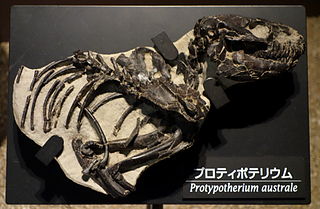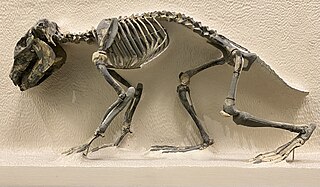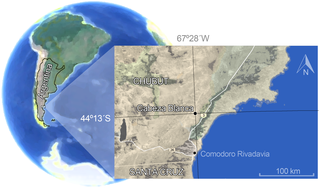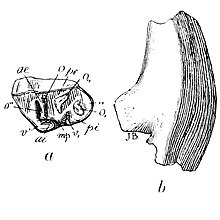Classification
The genus Argyrohippus (whose name means "Argentine horse") was first described in 1902 by Florentino Ameghino, based on fossil remains found in Early Miocene deposits in Argentina. The type species is Argyrohippus fraterculus; Ameghino described another species, A. boulei, mainly differentiated from the type species by some dental characteristics, like its more protruding incisors, and by its greater size. In 1935, a new species was described by Bryan Patterson, A. praecox, from the Late Oligocene of Argentina, with more brachydont teeth.
Argyrohippus has historically been classified as a member of Notohippidae, a group of notoungulates with teeth similar to those of horses. However, this family is now considered paraphyletic, and several forms included in it may in reality be ancestral to the family Toxodontidae. Argyrohippus may be one of those forms.

Pyrotherium is an extinct genus of South American ungulate in the order Pyrotheria, that lived in what is now Argentina and Bolivia during the Late Oligocene. It was named Pyrotherium because the first specimens were excavated from an ancient volcanic ash deposit. Fossils of the genus have been found in the Deseado and Sarmiento Formations of Argentina and the Salla Formation of Bolivia.

Protypotherium is an extinct genus of notoungulate mammals native to South America during the Oligocene and Miocene epochs. A number of closely related animals date back further, to the Eocene. Fossils of Protypotherium have been found in the Deseadan Fray Bentos Formation of Uruguay, Muyu Huasi and Nazareno Formations of Bolivia, Cura-Mallín and Río Frías Formations of Chile, and Santa Cruz, Salicas, Ituzaingó, Aisol, Cerro Azul, Cerro Bandera, Cerro Boleadoras, Chichinales, Sarmiento and Collón Curá Formations of Argentina.

Cramauchenia is an extinct genus of litoptern South American ungulate. Cramauchenia was named by Florentino Ameghino. The name has no literal translation. Instead, it is an anagram of the name of a related genus Macrauchenia. This genus was initially discovered in the Sarmiento Formation in the Chubut Province, in Argentina, and later it was found in the Chichinales Formation in the Río Negro Province and the Cerro Bandera Formation in Neuquén, also in Argentina, in sediments assigned to the SALMA Colhuehuapian, as well as the Agua de la Piedra Formation in Mendoza, in sediments dated to the Deseadan. In 1981 Soria made C. insolita a junior synonym of C. normalis. A specimen of C. normalis was described in 2010 from Cabeza Blanca in the Sarmiento Formation, in sediments assigned to the Deseadan SALMA.

Interatherium is an extinct genus of interatheriid notoungulate from the Early to Middle Miocene (Colhuehuapian-Mayoan). Fossils have been found in the Santa Cruz, Collón Curá and Sarmiento Formations in Argentina.

Prosotherium is an extinct genus of late Oligocene hegetotheriid notoungulate. It has been found in two Argentinian fossil formations, ie, the Sarmiento Formation in Chubut Province, and the Agua de la Piedra Formation in Mendoza Province.
Proadinotherium is an extinct genus of toxodontid. It lived between the Late Oligocene and the Early Miocene in what is now South America.
Pseudhyrax is an extinct genus of archaeohyracid notoungulate. It lived from the Late Eocene to the Early Oligocene, of what is now South America.

Periphragnis is an extinct genus of isotemnid notoungulates that lived from the Middle Eocene to the Early Oligocene in what is now Argentina and Chile.

Eomorphippus is an extinct genus of notohippid notoungulate that lived from the Late Eocene to the Early Oligocene in what is today South America.
Eurygenium is an extinct genus of notoungulate belonging to the family Notohippidae. It lived during the Late Oligocene in what is today South America.

Morphippus is an extinct genus of notohippid notoungulate that lived during the Middle to Late Oligocene in what is now South America.
Ancylocoelus is an extinct genus of mammal, belonging to the order Notoungulata. It lived during the Late Oligocene, in what is today Argentina, in South America.
Colpodon is an extinct genus of herbivorous mammal, belonging to the order Notoungulata. It lived during the Early Miocene, in what is today Argentina and Chile, in South America.
Argyrohyrax is an extinct genus of interatheriid notoungulate that lived during the Late Oligocene, of what is now Argentina and Bolivia.
Santiagorothia is an extinct genus of interatheriid notoungulate. It lived during the Early Oligocene, and its fossils were discovered in Argentina and Chile.

Notopithecus is an extinct genus of Notoungulate, belonging to the suborder Typotheria. It lived from the Middle to the Late Eocene and its fossilized remains were discovered in South America.

The Sarmiento Formation, in older literature described as the Casamayor Formation, is a geological formation in Chubut Province, Argentina, in central Patagonia, which spans around 30 million years from the mid-Eocene to the early Miocene. It predominantly consists of pyroclastic deposits, which were deposited in a semi-arid environment. It is divided up into a number of members. The diverse fauna of the Sarmiento Formation, including a variety of birds, crocodilians, turtles and snakes, also includes many mammals such as South American native ungulates as well as armadillos, and caviomorph rodents.
Teushentherium is an extinct genus of notohippid notoungulate from the Oligocene of Argentina. Fossils have been found in the Sarmiento Formation of Argentina.
Rosendo is an extinct genus of notohippid notoungulates that lived during the Early Oligocene in what is now Argentina and Chile. Fossils of this genus have been found in the Sarmiento Formation and the Abanico Formations of Argentina and Chile.
Moqueguahippus is an extinct genus of notohippid notoungulates that lived during the Late Oligocene of what is now Peru. Fossils of this genus have been found in the Moquegua Formation of Peru, which it was named after.


















